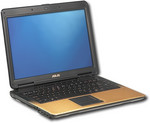Asus X83VM
Specifications

Price comparison
Average of 1 scores (from 2 reviews)
Reviews for the Asus X83VM
Source: Notebookreview.com
 Archive.org version
Archive.org versionThe ASUS X83 has a bunch of tiny little issues, but no deal-breakers, and for the money it's practically a steal. If you're like me and not at all a fan of the push to 16:9 computer screens (which are being basically forced on us whether we like them or not) then you'll be happy to know the X83 still has a good old 16:10. To me, there are just too many perks for the price to make it anything less than totally worth picking up if you need something portable that you can use for gaming.
Leistung 80, Display 80, Emissionen 90
Single Review, online available, Long, Date: 06/30/2009
Rating: performance: 80% display: 80% emissions: 90%
Source: CNet
 Archive.org version
Archive.org versionThe Asus X83VM-X1 is a well-rounded 14-inch mainstream laptop. It boasts a pleasing design (aside from the stiff, loud mouse buttons), and excellent application performance and 3D graphics performance for the money.
(von 10): 8, Ausstattung 9, Leistung 9, Mobilität 6, Verarbeitung gut, Display gut
Single Review, online available, Medium, Date: 11/07/2008
Rating: Total score: 80% performance: 90% features: 90% display: 80% mobility: 60% workmanship: 80%
Comment
NVIDIA GeForce 9600M GS: Slower clocked 9600M GT and therefore a bit slower and cooler. In conjunction with an 9100M the 9600M GS is able to use HybridPower to save current.
Only some 3D games with very low demands are playable with these cards.
» Further information can be found in our Comparison of Mobile Graphics Cards and the corresponding Benchmark List.
Intel Core 2 Duo: This is the Core Duo and Core Solo successor with a longer pipeline and 5-20% more speed without more power consumption. As an addition to the Core Duo design there exists a fourth decoder, an amplified SSE-unit and an additional arithmetical logical unit (ALU).
The Core 2 Duo for laptops is identical to the desktop Core 2 Duo processors but the notebook-processors work with lower voltages (0.95 to 1188 Volt) and a lower Frontside bus clock (1066 vs 667 MHz). The performance of equally clocked notebooks is 20-25% lower than Desktop PCs because of the lower Frontside bus clock and the slower hard disks.
P8400:
Middle class dual core CPU with a TDP of 25 Watt. For high end gamer the performance could be not sufficient (for class 1 graphic cards).
» Further information can be found in our Comparison of Mobile Processsors.













